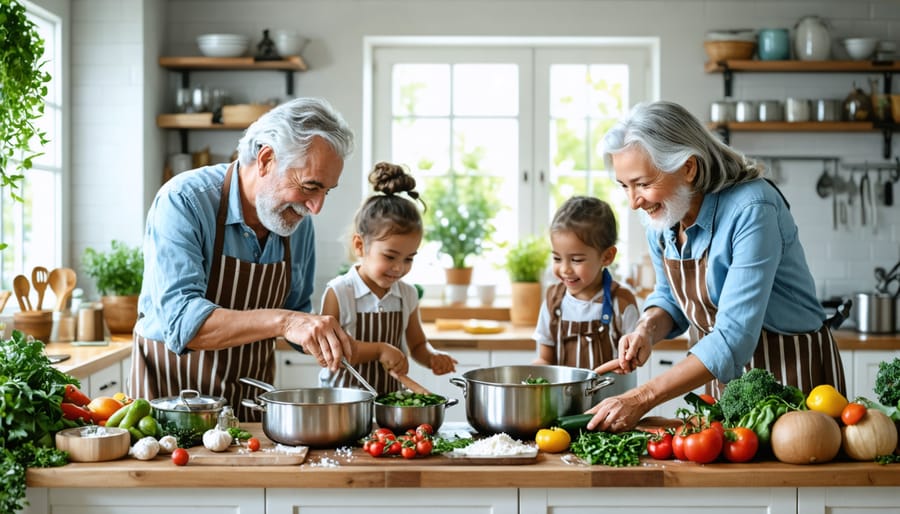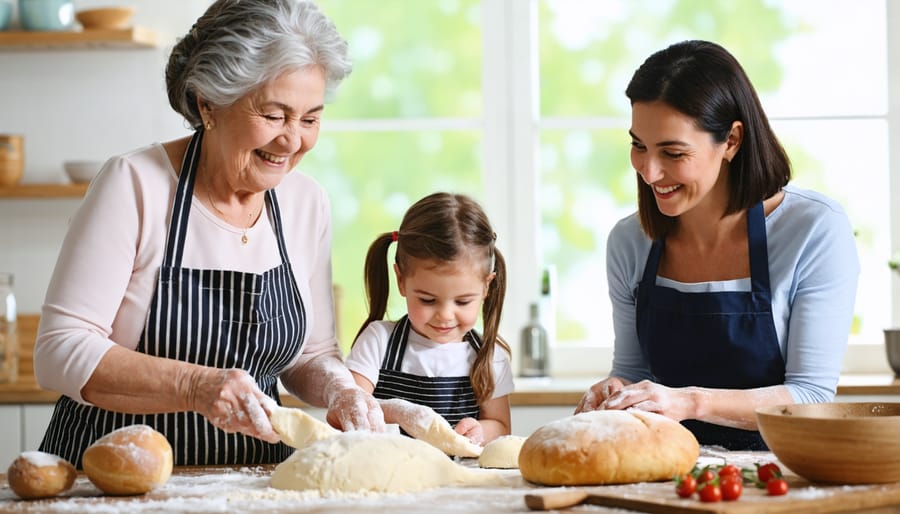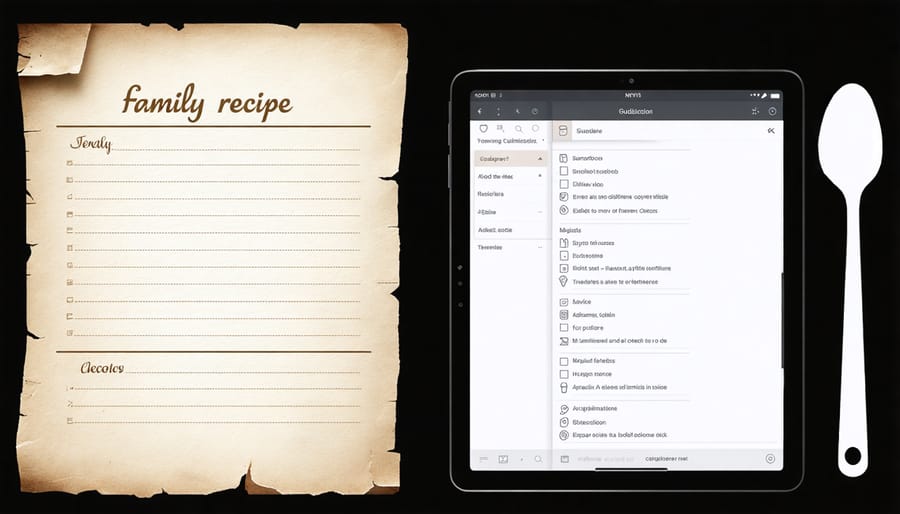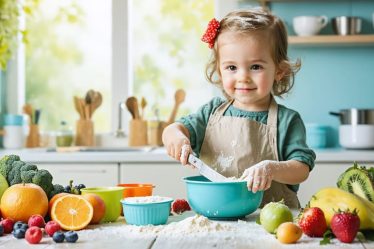
Picture a kitchen where four generations gather, sharing stories as rich as the aromas filling the air. Intergenerational family cooking isn’t just about preparing meals—it’s about weaving together the threads of our heritage, one recipe at a time. When grandparents teach grandchildren the secret to perfect pie crust, or millennials introduce their parents to trendy global cuisines, something magical happens: wisdom flows both ways, traditions evolve, and bonds strengthen.
In today’s fast-paced world, where digital connections often replace physical ones, cooking together offers a precious opportunity to slow down and truly connect. It’s a natural bridge between generations, where stories of childhood memories mingle with modern dietary preferences, and ancient family recipes meet contemporary cooking techniques. Whether it’s weekend baking sessions with grandma or teaching tech-savvy teens to appreciate the patience required for slow-cooked dishes, these shared culinary experiences create lasting memories and preserve family heritage.
This delicate dance of old and new, tradition and innovation, makes intergenerational cooking more than just a family activity—it’s a celebration of continuity, an education in heritage, and a testament to how food brings people together across the ages.
Why the Kitchen is Your Family’s Secret Bonding Space

Beyond Recipes: Creating Lasting Memories
When we gather in the kitchen, we’re not just making meals – we’re crafting memories that will be cherished for generations. I still remember standing on a stepping stool next to my grandmother, watching in wonder as she transformed simple ingredients into magical dishes. Through mindful cooking techniques, these kitchen moments become opportunities for storytelling, laughter, and meaningful connection.
Every spilled ingredient becomes a funny story to share at future gatherings. The slightly burnt cookies remind us of that time we got caught up in conversation and lost track of time. These “kitchen fails” often become the most treasured memories, teaching us that perfection isn’t the goal – it’s the journey together that matters most.
Create your own tradition of recording these precious moments. Start a family recipe journal where everyone can contribute not just recipes, but the stories behind them. Take photos of your cooking sessions, capture videos of grandma showing the perfect way to knead dough, or record audio of the kitchen conversations that naturally flow while preparing meals together. These documented memories become priceless family heirlooms, carrying forward the legacy of love, food, and family connection for future generations to cherish.
Natural Learning and Teaching Moments
The kitchen has always been a natural classroom where wisdom flows freely between generations. Watch as grandmother’s hands guide tiny fingers in forming the perfect dumpling pleats, or listen to the stories that emerge while Dad explains his secret marinara sauce recipe that’s been passed down three generations. These moments of connection happen organically, creating lasting memories while transferring invaluable knowledge.
Cooking together offers countless opportunities for natural teaching moments. When a child measures ingredients, they’re learning fractions. When teenagers help plan meals, they’re developing budgeting and organizational skills. As older family members share traditional recipes, they’re passing down cultural heritage and family history through stories and techniques that can’t be found in any cookbook.
These exchanges go both ways too. Younger generations often introduce older relatives to new ingredients or cooking methods, while seniors share time-tested techniques and family traditions. This beautiful give-and-take creates a rich learning environment where everyone, regardless of age, has something valuable to contribute to the family’s culinary legacy.
Setting Up Your Intergenerational Kitchen
Making Your Kitchen Age-Friendly
Creating a kitchen that works for everyone, from grandma to the little ones, doesn’t have to be complicated or expensive. I learned this firsthand when my mother-in-law moved in with us last year, and we needed to make our cooking space more accessible for three generations.
Start by organizing your kitchen with frequently used items at arm’s reach. Install pull-out drawers in lower cabinets and consider adding a few sturdy step stools for younger family members. Lighting is crucial too – under-cabinet lights can help everyone see better while preparing meals.
Investing in the right age-friendly kitchen tools can make a world of difference. Look for items with comfortable, easy-grip handles and consider electric can openers and jar openers that reduce strain on hands. A kitchen island at varying heights can accommodate both standing adults and seated grandparents.
Safety features like automatic shut-off appliances and clearly marked controls benefit everyone. Non-slip mats near the sink and prep areas prevent accidents, while rounded corner protectors on countertops keep little ones safe. Consider installing a pull-down faucet that’s easier to reach and control.
Remember, these adaptations aren’t just about accessibility – they’re about creating a space where everyone feels confident and capable in the kitchen. When my 80-year-old mother-in-law can safely prepare her famous lasagna while my 6-year-old helps with measuring ingredients, I know we’ve created something special.

Choosing the Right Recipes
Selecting the right recipes for intergenerational cooking is about finding that sweet spot where everyone can contribute meaningfully. I’ve learned through countless family gatherings that the best recipes are those that offer multiple roles – from simple tasks for little hands to more complex steps for experienced cooks.
Consider starting with recipes that have distinct, manageable steps. Cookie-making is a perfect example: younger children can help measure ingredients or shape the dough, while older family members handle the oven duties. Family-favorite casseroles often work well too, as they typically involve several preparation stages that can be divided among different skill levels.
Look for recipes that incorporate traditional family elements while remaining approachable. Maybe Grandma’s legendary lasagna can be simplified without losing its essence, or perhaps that complex holiday bread recipe can be broken down into more manageable steps that everyone can help with.
Some reliable options include:
– Build-your-own pizza nights where everyone customizes their portion
– Assembly-line style tacos or sandwiches
– Simple bread recipes that involve kneading (perfect for all ages)
– No-bake desserts that are safe for younger helpers
– Classic family recipes that can be modified for different ability levels
Remember to choose recipes that allow for conversation and connection while cooking. The best intergenerational recipes aren’t just about the food – they’re about creating spaces where stories can be shared and memories made while working together toward a delicious goal.
Building Your Family Cookbook Together
Documenting Family Food Stories
Creating a family food legacy starts with capturing those precious kitchen memories and cherished recipes that have been passed down through generations. One of the most meaningful ways to begin preserving food traditions is by starting a family recipe journal. Whether digital or handwritten, include not just ingredients and methods, but the stories behind each dish – like how Grandma learned to make her famous apple pie during wartime rationing.
Consider recording cooking sessions with older family members, capturing their techniques and the wisdom they share while preparing family favorites. These videos become precious time capsules of kitchen knowledge and family history. Create a shared digital folder where family members can contribute photos of holiday meals, special celebrations, or everyday cooking moments.
Don’t forget to document the little details that make each recipe special – the specific way Mom folds her empanadas or the secret ingredient Aunt Sarah adds to her marinara sauce. Include notes about which family member loves each dish the most and the occasions when these recipes typically appear on the table.
Write down the memories associated with particular dishes, like the summer afternoons spent shelling peas on the porch or the traditional Sunday dinners that brought everyone together. These stories become just as valuable as the recipes themselves, creating a lasting legacy for future generations to cherish and continue.
Modern Meets Traditional
There’s something magical about watching your grandmother’s time-tested recipes come to life with a modern twist. While traditional cooking methods hold irreplaceable charm, incorporating contemporary techniques can make family recipes more accessible and exciting for younger generations.
Consider transforming your great-aunt’s slow-cooked Sunday roast into an Instant Pot masterpiece that preserves all the flavors while fitting into today’s busy schedules. Or reimagine grandma’s labor-intensive hand-rolled pasta using a pasta machine, turning it into a fun family activity rather than a solo kitchen marathon.
The key is maintaining the essence of traditional recipes while embracing new possibilities. Try photographing the original handwritten recipe cards and creating digital versions that include both traditional and modern preparation methods. This preserves family history while making recipes more shareable and adaptable.
Many families find success in hosting “fusion cooking days” where older generations demonstrate traditional techniques while younger members suggest modern alternatives. For instance, using an air fryer to achieve the same crispy texture your grandfather’s deep-fried chicken was famous for, or incorporating healthier ingredients without compromising the authentic taste that makes these dishes special.
Remember, modernizing family recipes isn’t about replacing tradition – it’s about building bridges between generations through shared culinary experiences.

Making It a Regular Thing
Planning Your Kitchen Time Together
Finding the perfect time for everyone to gather in the kitchen can feel like solving a puzzle, but with a little creativity and organization, planning family cooking sessions becomes much easier. Start by creating a shared digital calendar where family members can mark their availability. Sunday afternoons often work well for many families, but don’t be afraid to think outside the box – maybe Saturday breakfast is your family’s sweet spot!
Consider setting up a regular monthly schedule, like the first and third Saturdays, to create a routine everyone can count on. This helps build anticipation and makes it easier for family members to plan around these special times. If you have family members who live far away, try scheduling virtual cooking sessions where everyone prepares the same recipe in their own kitchens while connected via video chat.
When organizing your cooking sessions, send out recipe plans at least a week in advance. This gives everyone time to gather ingredients and mentally prepare for their roles in the kitchen. For younger children or elderly family members, consider shorter sessions of 1-2 hours to keep energy levels high and engagement strong.
Remember to be flexible – sometimes the best memories come from spontaneous cooking moments. Keep basic ingredients on hand for impromptu sessions when schedules unexpectedly align. The key is creating an environment where cooking together feels natural and enjoyable, not like another obligation on the calendar.
Special Occasions and Everyday Moments
Family cooking naturally revolves around celebrations and special occasions, but the real magic happens in those everyday moments shared in the kitchen. While holiday feasts and birthday dinners create lasting memories, it’s the regular weeknight meals where true intergenerational bonds are strengthened and traditions take root.
Consider establishing a weekly family cooking night where different generations take turns leading the meal preparation. Grandma might share her secret marinara recipe on one Sunday, while your tech-savvy teenager introduces the family to a trendy recipe they discovered online the next week. These consistent cooking sessions create a comfortable routine that everyone can look forward to.
Balance special occasion cooking by involving multiple generations in both the planning and execution. Let younger family members help with menu planning for holiday meals, while older relatives can share traditional recipes and techniques. This collaborative approach makes celebrations more meaningful while teaching valuable skills.
For everyday cooking, keep things simple and stress-free. Create a family recipe rotation that includes everyone’s favorites, and assign age-appropriate tasks to each family member. Maybe grandpa handles the seasoning while the little ones wash vegetables and set the table. Remember, it’s not about creating elaborate meals every day – it’s about sharing time together in the kitchen, telling stories, and making memories over simple, home-cooked dishes.
The joy of cooking together across generations extends far beyond the delicious meals we create. As we’ve explored, intergenerational cooking offers a unique opportunity to strengthen family bonds, preserve cherished traditions, and create lasting memories that will be treasured for years to come.
When we invite our children, parents, and grandparents into the kitchen, we’re not just teaching them recipes – we’re sharing stories, wisdom, and love. The simple act of preparing a family meal together becomes a powerful tool for connection, helping bridge generational gaps and fostering understanding between different age groups.
Starting your own intergenerational cooking tradition doesn’t require grand gestures or elaborate plans. Begin with simple weekly cooking sessions, perhaps choosing a favorite family recipe or exploring new cuisines together. Make it a point to document these moments – take photos, write down recipes, and record the stories shared during your cooking adventures.
Remember that each generation brings something valuable to the table. While grandparents might share time-tested techniques and traditional recipes, younger family members can introduce new flavors and modern cooking methods. This beautiful exchange of knowledge creates a rich tapestry of culinary experiences that benefits everyone involved.
So gather your loved ones, pull out those recipe cards, and start creating your own delicious legacy. The memories you make in the kitchen today will become the stories your family tells tomorrow.



